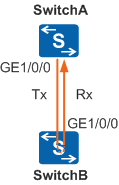Example for Configuring LBDT to Detect Loopbacks on an Interface
Overview
When a loop occurs on a network, broadcast, multicast, and unknown unicast packets are repeatedly transmitted on the network. This wastes network resources and may even cause a network breakdown. To minimize the impact of loops on a Layer 2 network, a detection technology that quickly notifies users of loops is required. When a loop occurs, users are requested to check network connections and configurations, and control the problematic interface.
Trap: The device reports a trap to the NMS and records a log, but does not take any action on the interface.
Block: The device blocks this interface, and can forward only BPDUs.
No learning: The interface is disabled from learning MAC addresses.
Quitvlan: The interface is removed from the VLAN where a loop occurs.
The problematic interface continues to send LBDT packets. After the configured recovery time expires, the system attempts to restore the problematic interface. If the device receives no LBDT packets from the problematic interface within the next recovery time, it considers that the loop is eliminated on the interface and restores the interface.
LBDT can only detect loops on a single node, but cannot eliminate loops on the entire network in the same manner as ring network technologies of ERPS, RRPP, SEP, Smart Link, and STP/RSTP/MSTP/VBST.
Configuration Notes
- This example applies to all versions of all S series switches.
In V200R008C00 and earlier versions, LBDT does not take effect in dynamic VLANs. In V200R008C00 and later versions, the LBDT-enabled switch can detect loops in dynamic VLANs, but the Quitvlan action is invalid for dynamic VLANs.
LBDT needs to send a large number of LBDT packets to detect loops, occupying system resources. Therefore, disable LBDT if loops do not need to be detected.
In versions earlier than V200R019C00, LBDT cannot be configured on an Eth-Trunk or its member interfaces. In V200R019C00 and later versions, LBDT can be configured on an Eth-Trunk but cannot be configured on its member interfaces.
On the S5720-EI, S5720-HI, S5730-HI, S5731-H, S5731-S, S5731S-H, S5731S-S, S5732-H, S6720-EI, S6720S-EI, S6720-HI, S6730S-H, S6730-H, S6730-S, and S6730S-S, manual LBDT can be configured on a maximum of 64 Eth-Trunks; on other models, manual LBDT can be configured on a maximum of 32 Eth-Trunks.
An interface can send LBDT packets with the specified VLAN tag only when the specified VLAN has been created.
When the PVID of the interface in the loop is the detected VLAN ID or the interface joins the detected VLAN in untagged mode, VLAN tags of LBDT packets are removed. As a result, the packet priority changes and the system may fail to detect loops.
When the Quitvlan action is used, the configuration file remains unchanged.
The LBDT action and MAC address flapping action affect each other, and cannot be configured simultaneously.
The Quitvlan action of LBDT conflicts with dynamic removal from VLANs (for example, GVRP and HVRP), and cannot be configured simultaneously.
- The blocked ports of LBDT cannot block GVRP packets. To ensure that GVRP runs normally and prevent GVRP loops, do not enable GVRP on the blocked port of LBDT.
On a modular switch, LBDT and loop detection (LDT) cannot be configured simultaneously.
Networking Requirements
In Figure 1, aggregation switch SwitchA on an enterprise network connects to access switch SwitchB. To prevent loopbacks on a TX-RX interface (GE1/0/0) because optical fibers are connected incorrectly or the interface is damaged by high voltage, SwitchA is required to detect loopbacks on GE1/0/0. Furthermore, it is required that the interface be blocked to reduce the impact of the loopback on the network when a loopback is detected, and the interface be restored after the loopback is removed.
Configuration Roadmap
To detect loopbacks on downlink interface GE1/0/0 of SwitchA, configure LBDT on GE1/0/0 of SwitchA. The configuration roadmap is as follows:
- Enable LBDT on GE1/0/0 of SwitchA to detect loopbacks.
- Configure an action to be taken after a loopback is detected and set the recovery time. After a loopback is detected, the Switch blocks the interface to reduce the impact of the loopback on the network. After a loop is eliminated, the interface can be restored.
Procedure
- Enable LBDT on an interface.
<HUAWEI> system-view [HUAWEI] sysname SwitchA [SwitchA] interface gigabitethernet 1/0/0 [SwitchA-GigabitEthernet1/0/0] loopback-detect enable //Enable LBDT on the interface. [SwitchA-GigabitEthernet1/0/0] quit
- Configure an action to be taken after a loop is detected and set the recovery time.
[SwitchA] interface gigabitethernet 1/0/0 [SwitchA-GigabitEthernet1/0/0] loopback-detect action block //Configure the Block action to be taken after a loop is detected. [SwitchA-GigabitEthernet1/0/0] loopback-detect recovery-time 30 //Set the recovery delay to 30s. [SwitchA-GigabitEthernet1/0/0] quit
- Verify the configuration.
Run the display loopback-detect command to check the LBDT configuration.
[SwitchA] display loopback-detect Loopback-detect sending-packet interval: 5 ---------------------------------------------------------------------------------- Interface RecoverTime Action Status ---------------------------------------------------------------------------------- GigabitEthernet1/0/0 30 block NORMAL ----------------------------------------------------------------------------------The preceding command output shows that the LBDT configuration is successful.
After about 5s, run the display loopback-detect command to check whether GE1/0/0 is blocked.
[SwitchA] display loopback-detect Loopback-detect sending-packet interval: 5 ---------------------------------------------------------------------------------- Interface RecoverTime Action Status ---------------------------------------------------------------------------------- GigabitEthernet1/0/0 30 block BLOCK(Loopback detected) ----------------------------------------------------------------------------------The preceding command output shows that GE1/0/0 is blocked, indicating that a loopback occurs on GE1/0/0.
Manually remove the loopback. Run the display loopback-detect command to check whether GE1/0/0 is restored.
[SwitchA] display loopback-detect Loopback-detect sending-packet interval: 5 ---------------------------------------------------------------------------------- Interface RecoverTime Action Status ---------------------------------------------------------------------------------- GigabitEthernet1/0/0 30 block NORMAL ----------------------------------------------------------------------------------The preceding command output shows that GE1/0/0 is restored.
